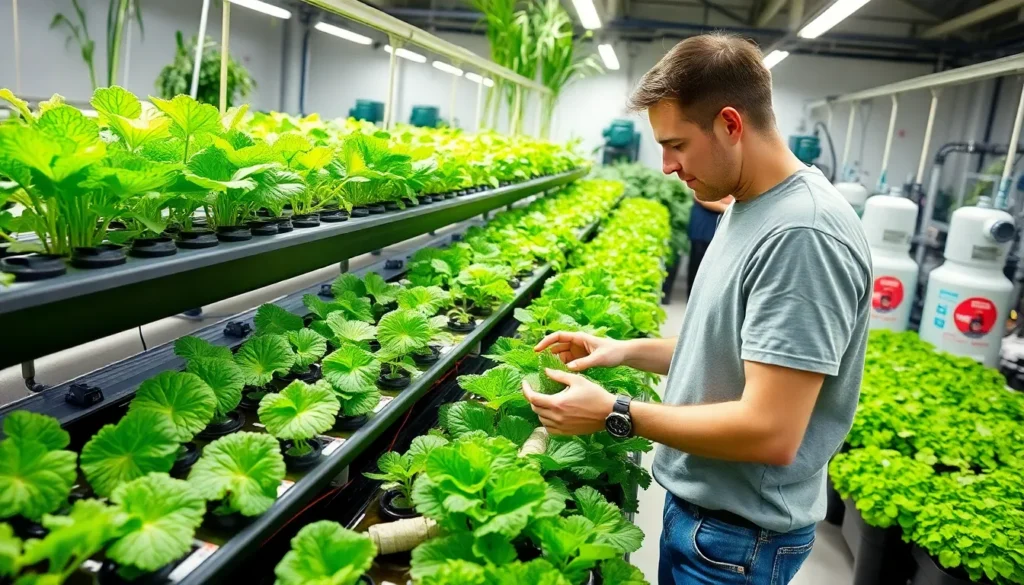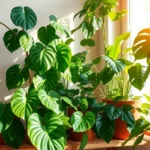We’ve all dreamed of growing fresh vegetables year-round without the hassle of soil and unpredictable weather. Nutrient Film Technique (NFT) hydroponics makes this dream a reality by delivering nutrients directly to plant roots through a thin film of flowing water.
This innovative growing method has revolutionized how we approach sustainable agriculture. NFT systems use minimal water while maximizing plant growth by creating an optimal balance of nutrients oxygen and moisture. Whether you’re a beginner gardener or an experienced grower we’ll show you why NFT hydroponics might be the perfect solution for your growing needs.
From leafy greens to herbs NFT systems consistently produce healthier plants with faster growth rates than traditional soil-based methods. We’ll explore everything you need to know about setting up and maintaining your own NFT hydroponic system so you can start harvesting fresh produce in just weeks.
What Is Nutrient Film Technique Hydroponics
Nutrient Film Technique hydroponics creates a continuous flow of nutrient-rich water that runs along the bottom of growing channels in a thin film. Plants sit in these sloped channels with their roots directly exposed to the flowing nutrient solution, eliminating the need for growing medium like soil or rockwool.
The system operates through gravity-fed circulation where water pumps deliver nutrients from a reservoir to the highest point of the growing channels. Water flows down the sloped channels at a rate of 1-2 liters per minute, providing constant access to nutrients and oxygen for plant roots. Excess solution collects at the lower end and returns to the reservoir for recirculation.
Three core components make NFT hydroponics function effectively:
- Growing channels – PVC pipes or specially designed gutters with 1:30 to 1:40 slope ratios
- Water pump system – Submersible pumps rated between 200-400 gallons per hour depending on system size
- Nutrient reservoir – Storage tanks holding 20-50 gallons of nutrient solution for most home systems
Plants in NFT systems develop two distinct root zones that optimize nutrient absorption. Feeder roots grow directly in the nutrient film to absorb water and minerals while air roots extend above the water line to access oxygen. This dual root system enables faster nutrient uptake compared to traditional soil growing methods.
Commercial NFT operations often use automated monitoring systems that track pH levels between 5.5-6.5 and electrical conductivity measurements of 1.2-2.0 for optimal plant nutrition. Home systems typically require manual monitoring every 2-3 days to maintain proper nutrient concentrations and water levels.
Benefits of NFT Hydroponics Systems
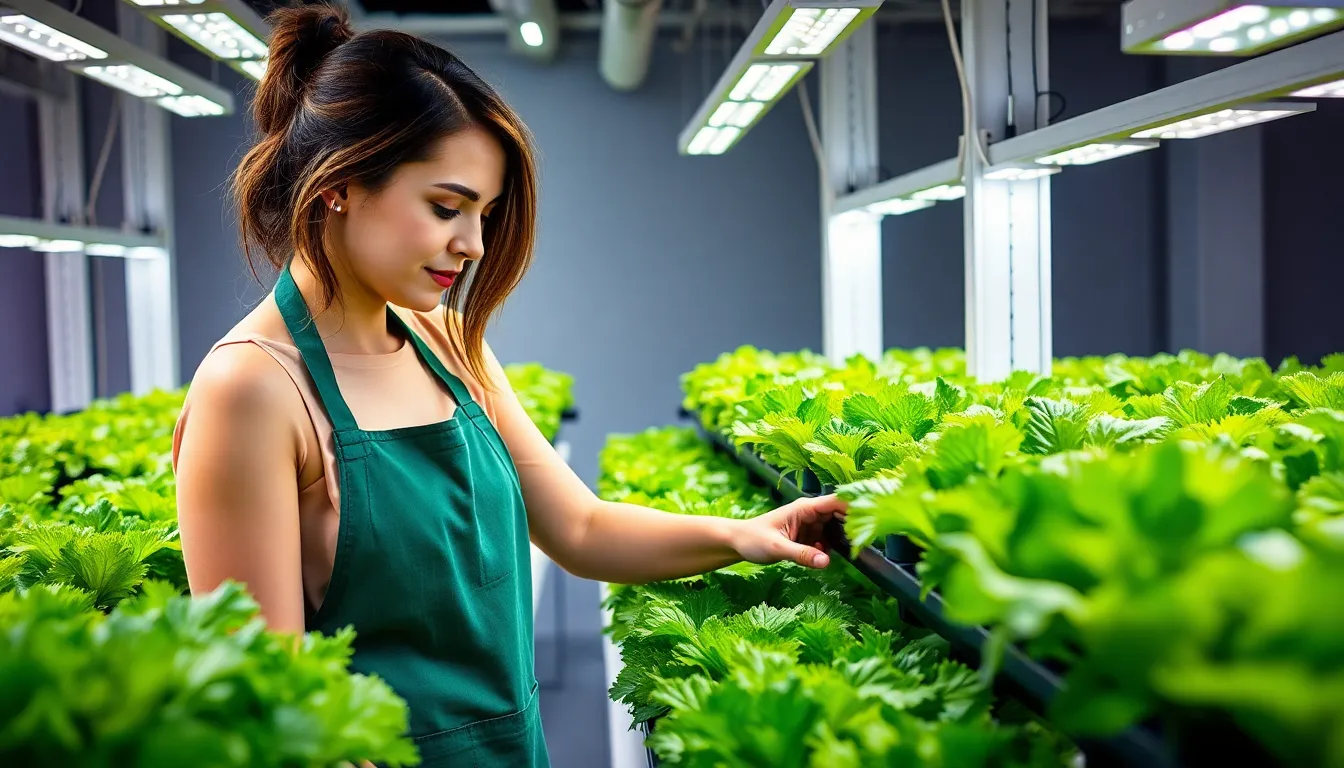
NFT hydroponics systems deliver exceptional water efficiency by saving up to 90% of water compared to traditional farming methods. Continuous recirculation of nutrient-rich solution eliminates waste while providing plants with optimal hydration levels.
Space optimization becomes a major advantage when implementing NFT systems in vertical farming configurations. Urban environments benefit significantly from this compact design since more plants fit into smaller areas while increasing overall yield per square foot.
Faster growth rates occur naturally as plant roots absorb nutrients directly from the flowing solution. This direct absorption leads to quicker crop cycles and higher yields compared to soil-based cultivation methods.
Disease prevention strengthens when plants grow without soil contact. Soil-borne pathogens cannot affect NFT-grown crops, resulting in healthier plants and reduced crop losses throughout the growing season.
Setup simplicity makes NFT systems accessible for both commercial operations and home growers. Maintenance requirements remain minimal once the initial installation is complete, allowing growers to focus on crop monitoring rather than system repairs.
Crop versatility extends to various plant types, particularly those with shallow root systems like lettuce and strawberries. Different vegetables thrive in NFT environments, giving growers flexibility in their crop selection strategies.
Year-round cultivation becomes possible when NFT systems integrate with controlled environment agriculture. Season independence allows continuous production regardless of external weather conditions or geographical limitations.
Commercial scalability supports operations ranging from small home setups to large agricultural facilities. The modular nature of NFT systems accommodates expansion without requiring complete system redesigns or replacements.
Materials and Equipment Needed
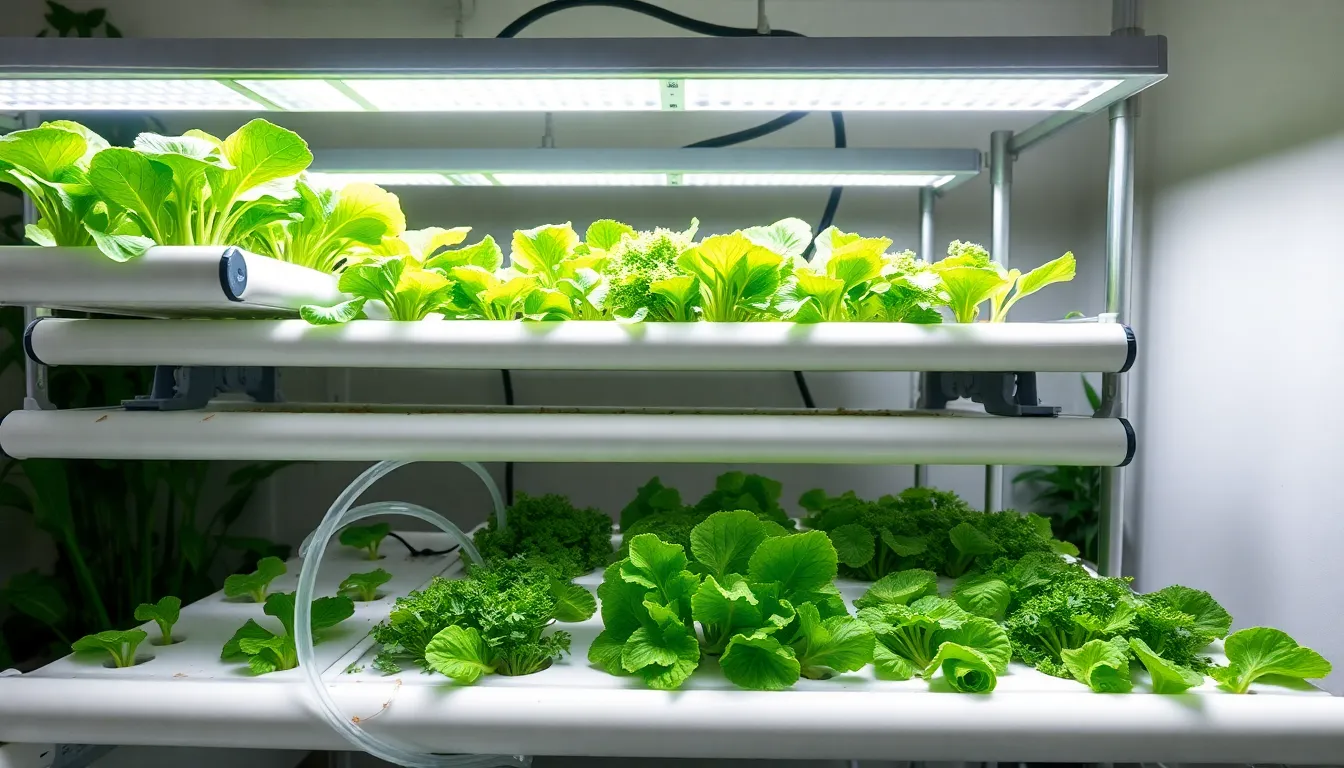
Building a successful NFT hydroponic system requires exact components that work together to create the continuous nutrient flow essential for plant growth. Each piece of equipment serves a critical function in maintaining the thin film of nutrient solution that defines this growing method.
NFT Channels and Gutters
NFT channels and gutters form the foundation of our hydroponic system by providing the necessary space for roots to grow and come into contact with the nutrient solution. These channels create the sloped pathways where plants sit and receive their continuous nutrient supply.
Choose channels made from food-grade PVC or similar materials that resist corrosion and maintain structural integrity over time. Square or rectangular channels with dimensions of 4-6 inches wide work best for most crops like lettuce, herbs, and strawberries. Install channels with a slope of 1:40 to 1:50 to ensure proper water flow without creating excessive speed that could damage delicate roots.
Position gutters to support multiple growing channels in commercial setups or larger home systems. Connect channels using appropriate fittings and seals to prevent leaks that could disrupt the nutrient flow. Clean channels regularly to prevent algae buildup and maintain optimal growing conditions.
Water Pump and Tubing
Water pumps and tubing deliver the nutrient solution from the reservoir to the growing channels, creating the circulation system that keeps plants nourished. Select pumps based on the total volume of your reservoir and the vertical height the water must travel.
Calculate pump capacity using the formula: reservoir volume ÷ 4 = minimum gallons per hour needed. Add 20% extra capacity to account for system losses and ensure consistent flow rates. Submersible pumps work well for most home systems, while inline pumps suit larger commercial operations.
Use food-grade tubing with diameters of ½ inch to ¾ inch for main distribution lines. Install smaller ¼ inch tubes for individual channel feeds to control flow rates precisely. Connect tubing with compression fittings or barbed connectors sealed with food-safe sealants.
Monitor tubing regularly for clogs or kinks that could interrupt nutrient delivery. Replace tubing every 2-3 years or when discoloration indicates material breakdown.
Nutrient Reservoir
Nutrient reservoirs hold the nutrient solution that gets pumped through our NFT system, serving as the central hub for plant nutrition. Size reservoirs to provide 2-4 gallons of solution per plant for optimal nutrient stability and pH buffering.
Construct reservoirs from opaque materials like black polyethylene or fiberglass to prevent light penetration that encourages algae growth. Install tight-fitting lids to minimize evaporation and contamination while allowing access for maintenance and monitoring.
Position reservoirs below the growing channels to take advantage of gravity return flow. Include drain valves at the lowest point for easy system cleaning and solution changes. Add air stones connected to aquarium pumps to maintain dissolved oxygen levels above 5 ppm.
Insulate reservoirs in extreme temperature environments to maintain solution temperatures between 65-72°F for optimal nutrient uptake.
Growing Medium and Net Pots
Growing media like perlite or coconut coir used in net pots help start seedlings, though this component becomes unnecessary in mature NFT systems as roots receive moisture and nutrients directly from the flowing solution. Choose net pots with 2-3 inch diameters for most leafy greens and herbs.
Start seeds in rockwool cubes or rapid rooter plugs before transferring to net pots filled with expanded clay pebbles or perlite. These media provide initial support while roots develop enough to anchor plants in the nutrient film.
Remove growing medium once roots establish contact with the flowing solution, typically after 2-3 weeks of growth. Clean and reuse net pots between growing cycles to reduce costs and waste.
Replace growing medium when it shows signs of degradation or salt buildup that could affect plant health.
pH and EC Meters
pH and EC meters monitor the pH and electrical conductivity of our nutrient solution to ensure optimal conditions for plant growth and nutrient absorption. Maintain pH levels between 5.5-6.5 for most crops grown in NFT systems.
Calibrate digital pH meters weekly using standard buffer answers of pH 4.0, 7.0, and 10.0. Store pH probes in proper storage solution to maintain accuracy and extend probe life. Clean probes with distilled water between measurements to prevent contamination.
Monitor electrical conductivity levels between 1.2-2.0 EC for most vegetables, with leafy greens thriving at the lower end of this range. Test EC levels daily during active growing periods and adjust nutrient concentrations accordingly.
Record pH and EC measurements in a log to track trends and identify potential problems before they affect plant health.
Lighting Equipment
Lighting equipment supplements natural light for vertical setups or low-light crops, ensuring consistent photosynthetic activity throughout the growing cycle. LED grow lights provide the most energy-efficient option for NFT systems.
Install full-spectrum LED fixtures with light intensities of 30-50 watts per square foot for leafy greens and herbs. Position lights 12-18 inches above plant canopies and adjust height as plants grow to maintain optimal light penetration.
Program lighting schedules to provide 14-16 hours of daily illumination for most crops. Use timers to automate lighting cycles and ensure consistent photoperiods that promote healthy growth patterns.
Monitor leaf temperature under lights to prevent heat stress, keeping leaf surfaces below 80°F through adequate ventilation or air circulation systems.
Setting Up Your NFT Hydroponics System
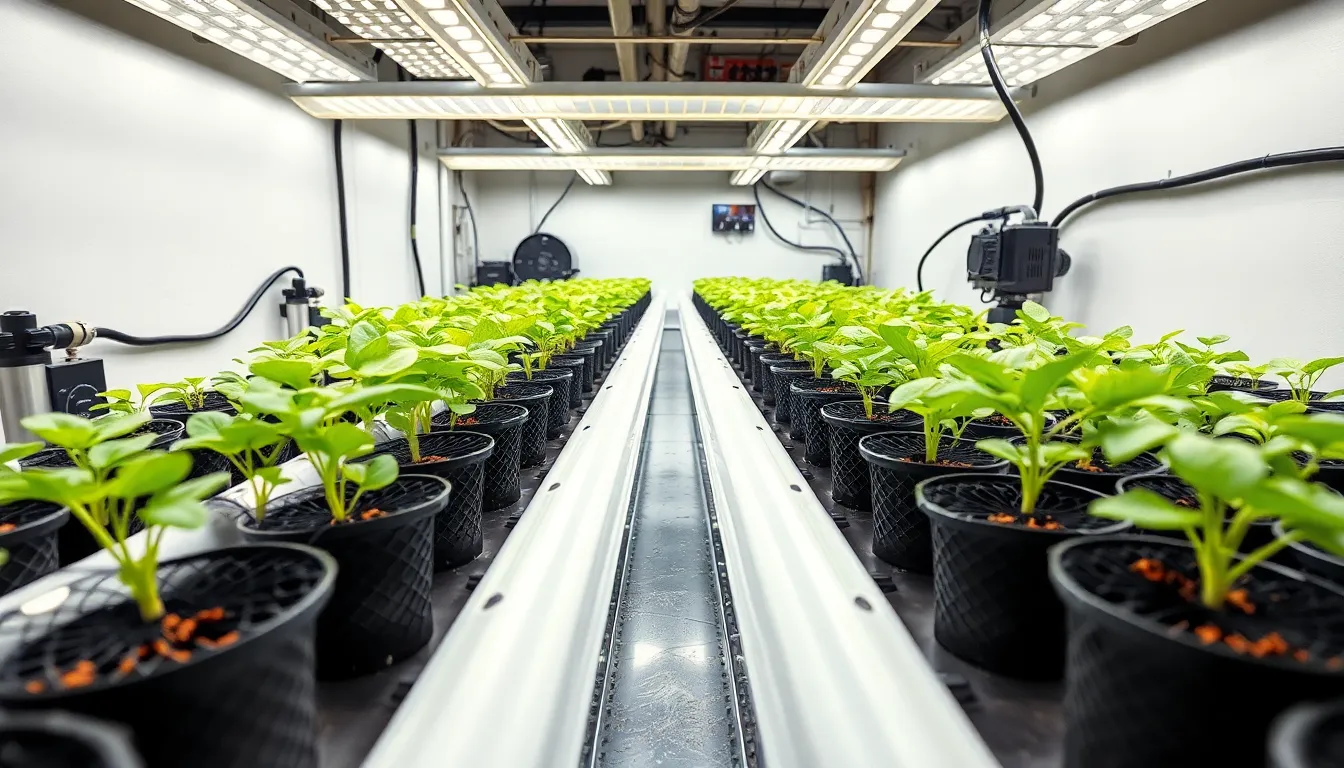
Building an NFT hydroponics system requires careful attention to component placement and water flow dynamics. Proper installation ensures optimal nutrient delivery to plant roots throughout the growing cycle.
Preparing the Growing Area
Location selection forms the foundation of NFT system success. Indoor setups benefit from LED grow lights that provide the complete light spectrum plants require for photosynthesis. Adequate lighting prevents stunted growth and maintains consistent crop production regardless of seasonal changes.
Channel assembly requires precise slope calculations to maintain proper nutrient flow rates. Installing growing channels at the correct angle ensures water moves efficiently from entry to exit points without stagnating. Proper slope prevents root rot while delivering continuous nutrient access to developing plants.
Installing the NFT Channels
PVC pipe channels create the primary growing environment for NFT hydroponic systems. Material selection focuses on food-grade options that resist algae buildup and maintain structural integrity under continuous water exposure. Channel positioning maintains the slight slope necessary for gravity-assisted nutrient flow back to the reservoir.
Hole spacing determines plant density and root development potential within each channel. Drilling holes at measured intervals accommodates net pots containing seedlings or established cuttings. Consistent spacing prevents overcrowding while maximizing growing capacity across the entire system layout.
Setting Up the Water Circulation System
Pump installation drives nutrient solution circulation throughout the NFT system. Reservoir-mounted pumps create the pressure needed to move water from the lowest collection point to the highest distribution channel. Proper pump sizing ensures adequate flow rates without overwhelming delicate root structures.
Tubing connections establish the nutrient delivery network between system components. Connecting pump output to channel entry points creates the distribution pathway for nutrient solution. Flow rate optimization prevents root damage while maintaining the thin film characteristic of NFT systems.
Slope and flow rate balance prevents common cultivation problems in hydroponic operations. Optimal angles range between 1:20 to 1:40 ratios depending on channel length and crop requirements. Proper calibration eliminates stagnant zones that promote bacterial growth and root disease.
Connecting the Reservoir and Pump
Reservoir preparation begins with water quality assessment and nutrient concentration mixing. Adding hydroponic nutrients at 20ml per gallon of water creates the baseline feeding solution for most leafy crops. Accurate measurement prevents nutrient burn while ensuring adequate plant nutrition throughout growth cycles.
pH monitoring maintains optimal growing conditions within the 5.5 to 6.5 range for maximum nutrient uptake. Regular testing prevents pH drift that reduces plant health and productivity. Digital meters provide precise readings necessary for consistent crop performance.
Circulation loop completion creates the continuous flow system characteristic of NFT hydroponics. Connecting return channels to the reservoir establishes the closed-loop design that recycles nutrient solution efficiently. This configuration minimizes waste while providing constant access to fresh nutrients and dissolved oxygen.
Preparing the Nutrient Solution
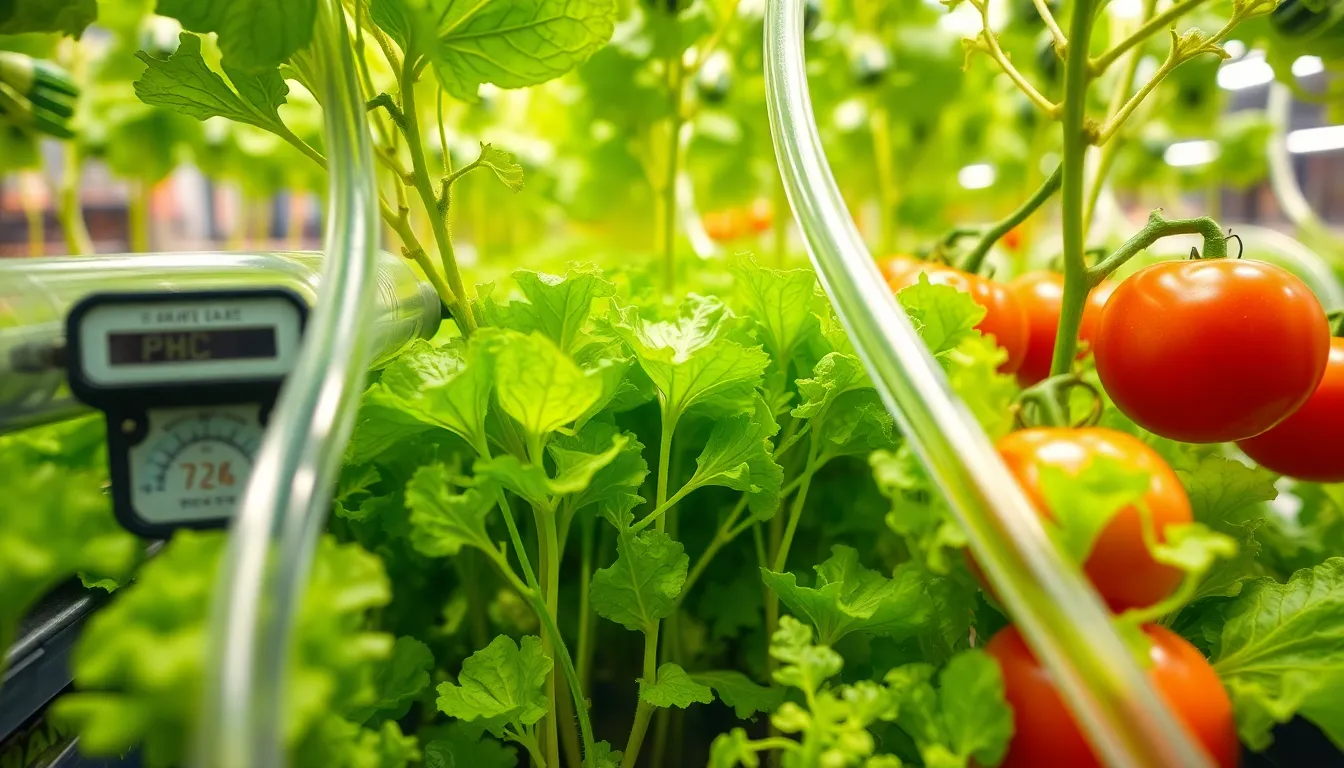
Creating the optimal nutrient solution forms the foundation of successful NFT hydroponics. Our nutrient solution provides plants with essential minerals and maintains proper growing conditions for maximum yields.
Mixing the Right Nutrient Concentrations
Commercial hydroponic nutrient answers deliver precise NPK ratios designed for plant growth stages. We select nutrient formulations based on crop requirements, with leafy greens like lettuce requiring different concentrations than fruiting plants. Most commercial answers provide balanced nitrogen, phosphorus, and potassium ratios ranging from 10-5-14 for vegetative growth to 4-18-38 for flowering stages.
Plant growth stages determine nutrient concentration adjustments throughout the growing cycle. Seedlings require diluted answers at 25% strength, while mature plants thrive with full-strength concentrations. We monitor plant response indicators such as leaf color and growth rate to fine-tune nutrient ratios.
Measuring nutrient concentrations involves calculating parts per million (PPM) or electrical conductivity readings. Target concentrations typically range from 800-1200 PPM for leafy greens and 1200-1600 PPM for fruiting crops. We replace nutrient answers every 7-14 days to maintain optimal concentrations.
Adjusting pH Levels
Most plants achieve optimal growth in pH ranges between 5.5 and 6.5 for maximum nutrient absorption. We test pH levels using digital meters or test strips before adding plants to the system. Nutrient uptake decreases significantly when pH levels fall outside this optimal range.
pH adjusters like phosphoric acid lower high pH readings, while potassium hydroxide raises acidic answers. We add pH adjusters gradually in small increments, testing after each addition to prevent overshooting target levels. Temperature affects pH readings, so we calibrate meters at solution temperature for accurate measurements.
Daily pH monitoring prevents nutrient lockout conditions that stunt plant growth. Solution pH naturally drifts over time as plants consume nutrients and root respiration changes water chemistry. We record pH trends to predict adjustment schedules and maintain stable growing conditions.
Testing Electrical Conductivity
Electrical conductivity measures ion concentration in nutrient answers between 1.0 and 2.0 mS/cm for optimal plant uptake. We use EC meters calibrated with standard answers to ensure accurate readings. Higher EC levels indicate concentrated nutrients, while lower readings suggest diluted answers.
Plant species determine exact EC requirements, with lettuce and herbs thriving at 1.2-1.6 mS/cm and tomatoes requiring 2.0-2.5 mS/cm. We adjust EC levels by adding concentrated nutrients to increase conductivity or diluting with water to decrease levels. Temperature compensation features in quality meters account for solution temperature variations.
Regular EC testing prevents nutrient burn from over-concentration and deficiency symptoms from weak answers. We test EC levels daily during active growth periods and weekly during slower growth phases. Maintaining consistent EC readings ensures steady nutrient availability throughout the growing cycle.
Planting and Transplanting Seedlings
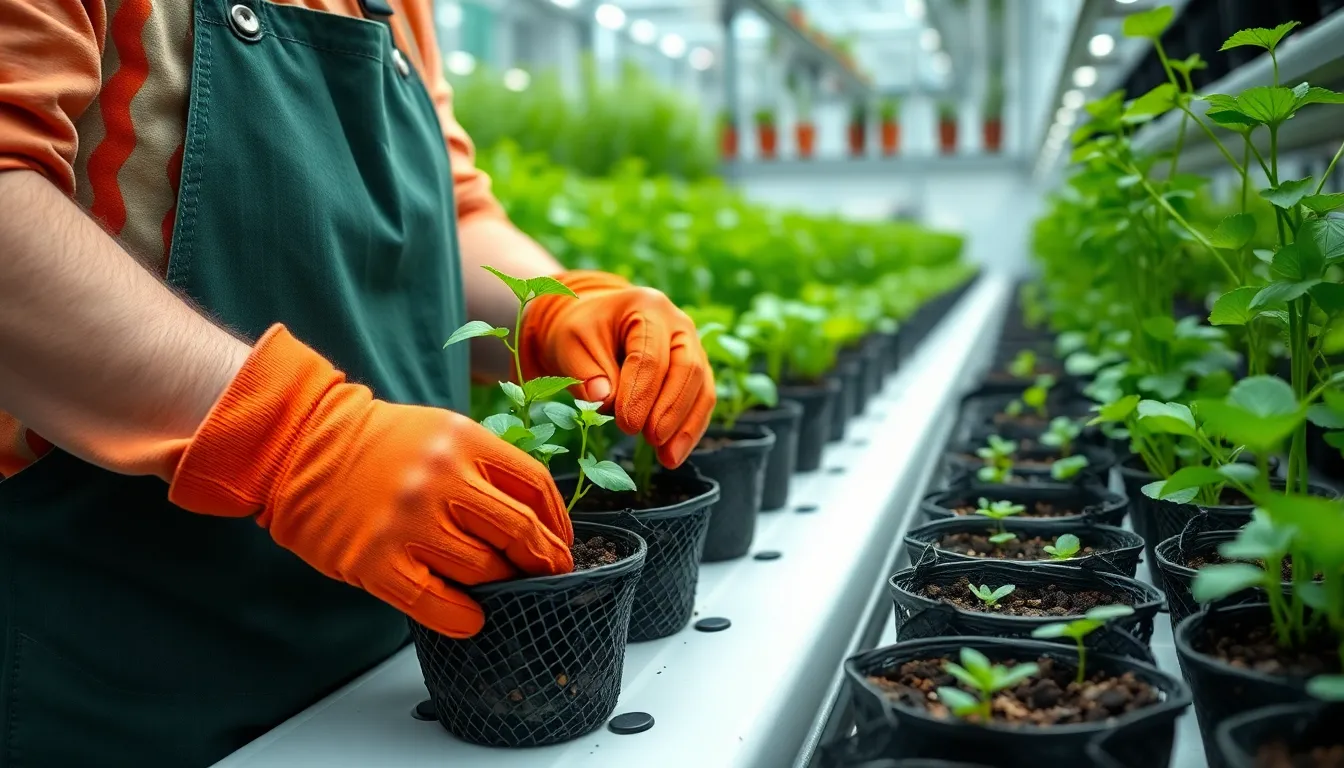
Successful nutrient film technique hydroponics begins with proper seedling preparation and strategic transplanting methods. Growing healthy seedlings requires exact growing mediums and careful timing for optimal root development.
Starting Seeds in Growing Medium
Seeds germinate most effectively in sterile growing mediums like perlite, coconut coir, or Rockwool before entering the NFT system. Perlite provides excellent drainage and aeration for delicate root systems during the first 7-14 days of growth. Coconut coir retains moisture while maintaining proper air circulation around developing roots. Rockwool cubes offer consistent water retention and pH stability for uniform germination rates.
We place seeds directly into pre-moistened growing medium and maintain temperatures between 65-75°F for optimal sprouting conditions. Germination typically occurs within 3-7 days depending on the crop variety and environmental conditions. Monitor seedlings daily for the first set of true leaves to appear after the initial cotyledon stage.
Transplanting into Net Pots
Transplanting occurs when seedlings develop 2-3 sets of true leaves and establish robust root systems within the growing medium. Net pots provide the perfect transition vessel for moving seedlings from germination trays into NFT channels. Choose 2-inch or 3-inch net pots based on the mature plant size and root system requirements.
Carefully remove seedlings from their germination medium and gently place them into net pots filled with additional growing medium. Position the root ball so existing roots can easily access the nutrient solution flowing through the channels. Secure seedlings firmly but avoid compacting the growing medium around delicate root structures.
Place net pots into pre-cut holes in the NFT channels with roots extending into the flowing nutrient solution. Root contact with the nutrient film typically establishes within 24-48 hours after transplanting.
Proper Spacing Guidelines
Crop selection determines optimal spacing requirements for NFT systems based on mature plant dimensions and root development patterns. Lettuce requires 6-8 inches between plants while herbs like basil need 8-12 inches for proper air circulation and light penetration.
Channel capacity limits the number of plants we can successfully grow without overcrowding root systems. Calculate total channel length and divide by plant spacing requirements to determine maximum plant density per channel.
| Crop Type | Spacing Distance | Plants per 10ft Channel |
|---|---|---|
| Lettuce | 6-8 inches | 15-20 plants |
| Basil | 8-12 inches | 10-15 plants |
| Spinach | 4-6 inches | 20-30 plants |
| Cilantro | 6-8 inches | 15-20 plants |
Root development thrives when channels provide unrestricted growth space without clogging the nutrient flow system. Maintain adequate spacing to prevent root entanglement and ensure consistent nutrient distribution throughout the entire channel length.
Maintaining Your NFT System
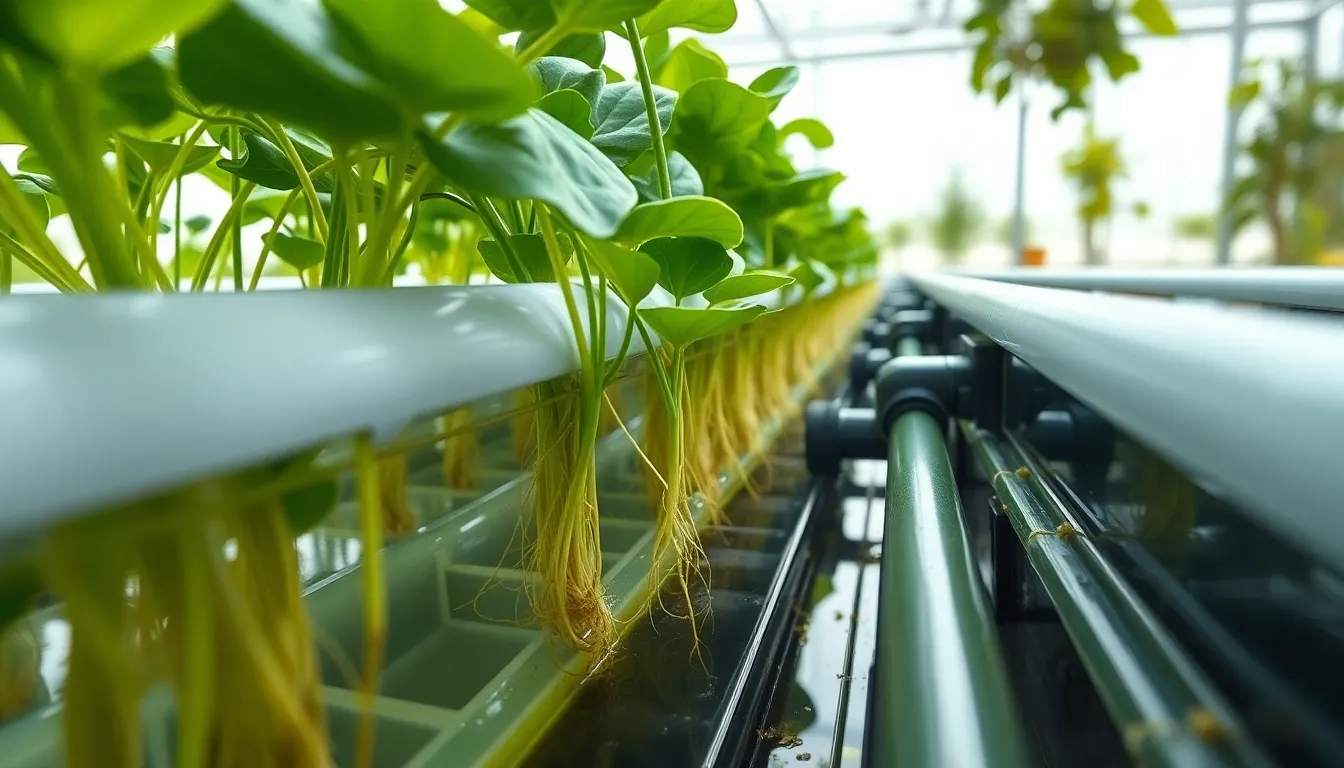
Consistent maintenance keeps your nutrient film technique system running efficiently and prevents costly crop failures. Regular monitoring and cleaning ensure optimal plant growth throughout the growing cycle.
Daily Monitoring Tasks
Water level checks form the foundation of daily NFT system maintenance. Monitor the reservoir to ensure adequate solution volume remains for continuous circulation. Low water levels disrupt nutrient flow and expose plant roots to air stress.
pH level testing maintains optimal nutrient absorption conditions between 5.5 and 6.5 for most crops. Use digital pH meters or test strips to measure solution acidity twice daily during peak growing periods. Adjust pH using phosphoric acid to lower or potassium hydroxide to raise levels when readings fall outside the target range.
Nutrient concentration monitoring prevents deficiencies and toxicities in your crops. Test electrical conductivity (EC) levels using digital meters to measure dissolved nutrient concentrations. Maintain EC readings between 1.2 and 2.0 for leafy greens and 2.0 and 3.0 for fruiting plants.
Flow rate verification ensures consistent nutrient delivery to all plants in your channels. Check that solution flows at 1-2 liters per minute through each channel. Inspect pump operation and clear any blockages in tubing or channel outlets that reduce flow rates.
Weekly Maintenance Schedule
Channel cleaning removes algae buildup and root debris that accumulate over time. Scrub growing channels with soft brushes to eliminate green algae growth without damaging plant roots. Focus cleaning efforts on areas where light exposure creates optimal algae growing conditions.
Net pot inspection identifies plants requiring additional support or replacement. Remove damaged or diseased plants immediately to prevent pathogen spread throughout the system. Replace worn net pots that no longer provide adequate plant support.
Nutrient solution replacement maintains optimal growing conditions for your crops. Replace 25% of the total solution volume weekly to prevent nutrient imbalances and salt accumulation. Mix fresh nutrients according to manufacturer specifications before adding to the reservoir.
Root system evaluation catches problems before they affect plant health. Examine exposed roots for brown coloration, mushy texture, or foul odors indicating root rot. Trim damaged root sections using sterile scissors to prevent disease spread.
Cleaning and Sanitizing Procedures
Equipment sanitization eliminates harmful bacteria and fungi between growing cycles. Mix bleach solution at 1 part bleach to 10 parts water for effective sanitization without damaging system components. Soak all removable parts including net pots, tubing, and pumps for 10 minutes in this solution.
System flushing removes sanitizing agents that could harm future crops. Run clean water through the entire circulation system for 30 minutes after sanitization to eliminate bleach residues. Test water pH and EC levels to confirm complete removal of cleaning agents.
Channel sterilization prevents pathogen carryover between crop cycles. Wipe down all channel surfaces with sanitizing solution using clean cloths or paper towels. Pay special attention to corners and joints where organic matter tends to accumulate and harbor harmful microorganisms.
Reservoir cleaning maintains water quality throughout the growing season. Empty and scrub the reservoir monthly using mild detergent followed by thorough rinsing. Inspect reservoir walls for cracks or damage that could harbor bacteria or affect system performance.
Nutrient Management and Feeding Schedules

NFT systems require consistent nutrient flow and regular monitoring to maintain optimal plant growth and prevent issues like clogs or nutrient imbalances. Continuous circulation of nutrient solution forms the foundation of successful NFT hydroponics.
Understanding Nutrient Requirements by Growth Stage
Plants in NFT systems demand different nutrient ratios depending on their development phase. Seedling stage plants require high levels of nitrogen and phosphorus for robust root development and establishment.
Vegetative stage cultivation benefits from balanced NPK ratios that support vigorous leaf growth and stem development. During this phase, plants consume nutrients rapidly as they build their structural foundation.
Flowering stage plants need increased phosphorus levels to enhance fruit production and reproductive development. This adjustment becomes critical for crops like tomatoes, peppers, and strawberries in NFT systems.
Adjusting Nutrient Strength Over Time
Nutrient concentration adjustments match plant maturity levels throughout the growing cycle. Seedlings perform best with weaker answers ranging from 400-600 ppm to prevent nutrient burn and root damage.
Mature plants tolerate stronger concentrations between 800-1200 ppm as their root systems develop greater absorption capacity. Regular testing helps maintain these optimal nutrient levels without causing deficiencies or toxicities.
Electrical conductivity monitoring provides accurate measurements for nutrient strength adjustments. Plants showing yellowing leaves or stunted growth indicate nutrient imbalances requiring immediate correction.
Replacing Nutrient Answers
Nutrient answers require replacement every 1-2 weeks to maintain optimal balance and prevent potential deficiencies or toxicities. This replacement schedule varies based on system size, plant density, and crop requirements.
Complete solution changes prevent nutrient buildup and pH drift that occurs as plants selectively absorb different elements. Fresh answers restore balanced mineral ratios essential for continued plant health.
Monitoring pH levels and electrical conductivity readings helps determine replacement timing. Answers showing important pH changes or nutrient depletion require immediate replacement regardless of the scheduled timeline.
Common Issues and Troubleshooting
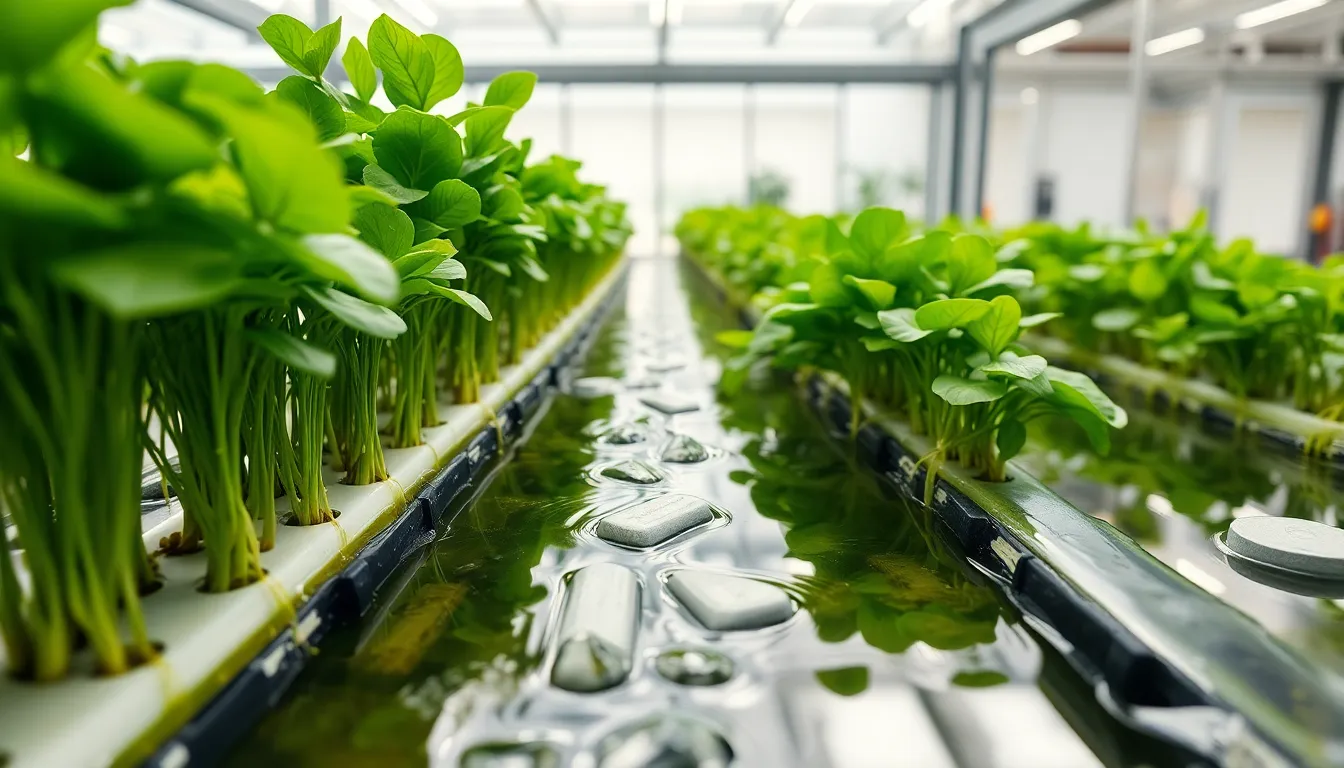
NFT hydroponic systems face exact challenges that require prompt attention to maintain optimal plant growth. Understanding these common problems and their answers prevents crop failures and maximizes system efficiency.
Pump Failures and Flow Problems
Pump malfunctions represent the most critical threat to NFT systems since plants depend entirely on continuous nutrient flow. Clogged channels disrupt the thin film of solution, leaving roots without access to essential nutrients and water. Regular inspection of pump components every 3-4 days prevents sudden failures that could damage entire crops within hours.
Clean debris from pump intakes weekly to maintain consistent water pressure throughout the system. Check tubing connections for loose fittings that reduce flow rates below the optimal 1-2 liters per minute for most NFT channels. Replace worn pump components immediately when flow rates drop below required levels.
Monitor channel slopes to ensure gravity assists nutrient circulation from the highest point to the reservoir. Adjust channel positioning if water pools in exact areas instead of flowing smoothly back to the collection point.
Nutrient Deficiencies and Toxicities
Imbalanced nutrient levels cause visible symptoms in plants within 5-7 days of occurrence. Nitrogen deficiency appears as yellowing lower leaves, while phosphorus deficiency creates purple leaf edges and stunted growth. Potassium deficiency manifests as brown leaf margins and reduced fruit production.
Test electrical conductivity levels twice weekly using a digital meter to maintain readings between 1.2-2.0 for most crops. Adjust nutrient concentrations based on plant growth stages, with seedlings requiring 0.8-1.2 EC and mature plants thriving at 1.6-2.0 EC levels.
Replace nutrient answers completely every 10-14 days to prevent salt buildup that leads to toxicity symptoms. Flush the system with clean water for 30 minutes before adding fresh nutrient mixtures to remove accumulated salts from channel surfaces.
Root Rot and Disease Prevention
Root rot develops when oxygen levels drop below 5 ppm in the nutrient solution, creating anaerobic conditions that promote harmful bacteria. Overwatering occurs when the nutrient film becomes too thick, preventing adequate air circulation around root systems. Brown, mushy roots indicate advanced root rot that spreads rapidly through NFT channels.
Maintain proper aeration by ensuring the nutrient film thickness stays below 3mm throughout the growing channels. Install air stones in the reservoir to increase dissolved oxygen levels above 6 ppm for healthy root development.
Remove affected plants immediately when root rot symptoms appear to prevent contamination of neighboring crops. Sanitize channels with a 10% bleach solution between growing cycles to eliminate pathogenic organisms from system surfaces.
Algae Growth Answers
Excessive light exposure in NFT channels creates ideal conditions for algae proliferation, which competes with plants for nutrients and clogs system components. Green slime formation typically occurs within 7-10 days of light penetration into nutrient answers.
Cover all exposed channels with opaque materials to block light from reaching the nutrient film. Use black plastic sheeting or aluminum foil to wrap transparent tubing that carries nutrient answers between system components.
Install UV sterilizers in the main circulation line to eliminate algae spores before they establish colonies in growing channels. Clean algae buildup from channel surfaces weekly using a soft brush to maintain smooth water flow patterns.
Apply beneficial bacteria supplements containing Bacillus species to outcompete algae for nutrients naturally. These microorganisms establish protective biofilms that prevent algae attachment to channel surfaces while supporting plant root health.
Best Plants for NFT Hydroponics
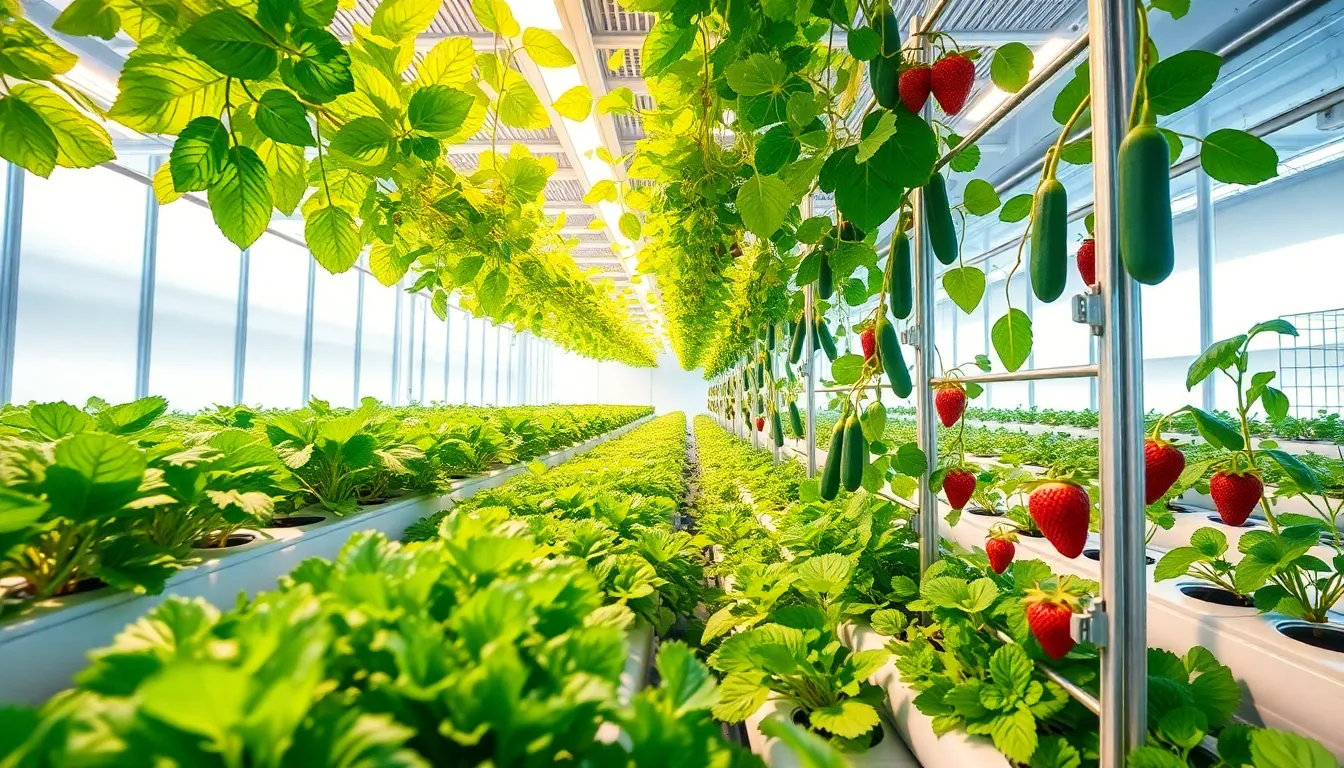
Selecting appropriate plants determines the success of your NFT hydroponic system. Leafy greens and herbs perform exceptionally well in NFT setups due to their shallow root systems and minimal space requirements.
Leafy Greens and Herbs
Lettuce varieties thrive in NFT systems because their compact root structure perfectly matches the shallow channel design. Spinach develops robust leaves when grown in continuous nutrient flow conditions. Popular herbs like basil, parsley, cilantro, and mint flourish in NFT environments due to their shallow root networks and rapid growth cycles.
These plants benefit from the constant nutrient availability that NFT systems provide. Arugula establishes quickly in flowing nutrient answers and produces tender leaves within 30-45 days. Kale varieties adapt well to NFT channels and maintain consistent growth throughout their cultivation period. Chard develops vibrant colored stems and leaves when exposed to continuous nutrient flow.
Growing leafy greens in NFT systems produces harvests 90% faster than traditional soil methods. Microgreens complete their growth cycle in 7-14 days when grown in optimized NFT conditions. Swiss chard varieties produce multiple harvests from single plantings in NFT setups.
Fruiting Plants Considerations
Strawberries and cucumbers adapt to NFT systems with proper structural support and channel modifications. These plants require additional trellising systems to support their weight during fruit production. Tomato varieties can grow in NFT systems but need wider channels to accommodate their extensive root development.
Cherry tomato plants produce continuous harvests when grown in modified NFT channels with 6-8 inch spacing. Pepper varieties establish well in NFT systems but require stable support structures during fruit development. Small melon varieties can succeed in NFT setups with reinforced channel systems and extended growing periods.
Fruiting plants demand higher nutrient concentrations compared to leafy greens. Strawberry plants benefit from specialized nutrient formulations during flowering and fruit development stages. Cucumber vines require consistent water flow rates to prevent fruit quality issues.
Root Crop Limitations
Root vegetables like carrots and potatoes cannot grow effectively in standard NFT systems due to channel depth restrictions. These crops require soil depth of 8-12 inches for proper root development. Radishes fail to develop properly in NFT channels because their taproot structure needs unrestricted downward growth space.
Beets and turnips struggle in NFT systems since their bulbous roots cannot expand within narrow channel confines. Onion varieties experience stunted growth when their root systems cannot spread adequately in shallow NFT channels. Sweet potato vines may grow but cannot produce tubers in the limited root space of NFT systems.
NFT channels typically measure 2-4 inches in depth, preventing root crops from achieving mature size. Garlic bulbs cannot form properly without sufficient soil depth for root anchor development. Parsnips require 12-18 inches of growing depth that NFT systems cannot accommodate.
Tips for Maximizing Yields

Optimizing crop selection and maintaining proper system conditions drive maximum productivity in NFT hydroponic systems. Strategic management of flow rates, environmental factors, and harvest timing creates the foundation for exceptional yields.
Optimizing Flow Rates
Consistent flow rates between 1-2 liters per minute per channel ensure optimal nutrient delivery without overwhelming plant roots. Faster flow rates above 3 liters per minute can cause root suffocation and nutrient lockout, while slower rates below 0.5 liters per minute create stagnant conditions that promote bacterial growth.
Textured channels and woven materials enhance nutrient distribution by creating turbulence that increases contact between roots and the nutrient solution. Installing small ridges or grooves along channel bottoms improves solution mixing and prevents nutrient stratification.
Regular flow rate monitoring prevents system failures that can destroy entire crops within hours. Checking flow rates every 2-3 days using a simple measuring cup and timer catches pump degradation before it affects plant health.
Environmental Control Strategies
Temperature regulation between 65°F and 75°F maintains optimal root zone conditions for maximum nutrient uptake. Temperatures above 80°F reduce dissolved oxygen levels and increase disease susceptibility, while temperatures below 60°F slow metabolic processes and reduce growth rates.
Supplemental LED lighting becomes essential in vertical NFT setups where upper plants shade lower levels. Installing 30-40 watts per square foot of full-spectrum LED lights ensures consistent photosynthesis across all growing levels.
Humidity control between 50-70% prevents fungal diseases while maintaining proper transpiration rates. Using exhaust fans and dehumidifiers keeps moisture levels optimal for leafy greens like lettuce and spinach.
Air circulation systems prevent stagnant air pockets that create disease-prone microclimates around plants. Positioning oscillating fans to create gentle air movement reduces humidity buildup without stressing plants.
Harvest Timing Guidelines
Cultivar-exact maturity indicators determine optimal harvest windows for maximum quality and yield. Lettuce varieties like Buttercrunch reach maturity in 35-45 days, while faster varieties like Red Sails finish in 28-35 days from transplant.
Continuous production scheduling maximizes system productivity by staggering plantings every 2-3 weeks. Replacing harvested plants immediately maintains consistent nutrient solution demands and prevents system imbalances.
Pre-harvest nutrient flushing for 3-5 days with plain water improves flavor quality in leafy greens and herbs. Reducing electrical conductivity to 200-400 ppm during this period removes excess salts while maintaining plant health.
Morning harvest timing captures peak turgor pressure when plants contain maximum water content and nutrients. Harvesting between 6-10 AM results in crisper texture and longer shelf life compared to afternoon harvests.
Conclusion
NFT hydroponics represents a game-changing approach to modern agriculture that we can carry out at any scale. Whether you’re starting with a small home system or planning a commercial operation the fundamentals remain the same: proper flow rates controlled nutrient delivery and consistent monitoring.
The water efficiency space optimization and year-round growing potential make NFT systems particularly valuable in our changing industry. With leafy greens and herbs thriving in these setups you’ll see faster growth rates and higher yields than traditional soil methods can provide.
Success with NFT hydroponics comes down to understanding the balance between nutrient flow environmental control and plant requirements. By following the setup guidelines and maintenance schedules we’ve outlined you’ll be well-equipped to grow healthy productive crops in your own nutrient film technique system.
Frequently Asked Questions
What is NFT hydroponics and how does it work?
Nutrient Film Technique (NFT) hydroponics is a soilless growing method where plants receive nutrients through a thin film of water flowing continuously along sloped channels. The system uses gravity-fed circulation with water pumps delivering nutrients from a reservoir to growing channels. Plant roots are directly exposed to the nutrient solution, allowing for optimal absorption of nutrients and oxygen while eliminating the need for soil or other growing mediums.
What are the main benefits of using NFT hydroponics?
NFT hydroponics offers exceptional water efficiency, using up to 90% less water than traditional farming. It provides faster plant growth rates, better disease prevention by eliminating soil-borne pathogens, and optimal space utilization through vertical farming configurations. The system allows for year-round cultivation, requires minimal maintenance after setup, and produces higher yields per square foot compared to conventional growing methods.
What equipment do I need to build an NFT system?
Essential components include NFT channels or gutters (preferably food-grade materials), a water pump system with appropriate capacity, tubing for water circulation, and a nutrient reservoir. You’ll also need growing channels with proper slope configuration, net pots for plants, pH testing equipment, and electrical conductivity meters. For indoor setups, LED grow lights are necessary to provide adequate illumination for plant growth.
Which plants grow best in NFT hydroponic systems?
Leafy greens and herbs like lettuce, spinach, kale, and basil thrive in NFT systems due to their shallow root structures and high nutrient demands. These plants benefit from constant nutrient availability, leading to faster harvests. Fruiting plants like strawberries and cucumbers can also be grown with proper support systems. However, root crops like carrots and potatoes are not suitable due to depth restrictions.
How often should I monitor and maintain my NFT system?
Daily monitoring includes checking water levels, pH levels (maintain 5.5-6.5), nutrient concentrations, and flow rates. Weekly maintenance involves cleaning channels, inspecting net pots, and replacing nutrient solutions every 1-2 weeks. Between growing cycles, thoroughly clean and sanitize all components to eliminate harmful bacteria. Regular testing of electrical conductivity ensures optimal nutrient levels for healthy plant growth.
What are common problems with NFT systems and how do I fix them?
Common issues include pump failures, nutrient deficiencies, root rot, and algae growth. Prevent pump failures with regular maintenance and backup systems. Address nutrient deficiencies by adjusting electrical conductivity and pH levels. Prevent root rot by maintaining proper flow rates and water quality. Control algae growth by covering channels to block light and maintaining clean water. Regular inspections help identify and resolve issues quickly.

